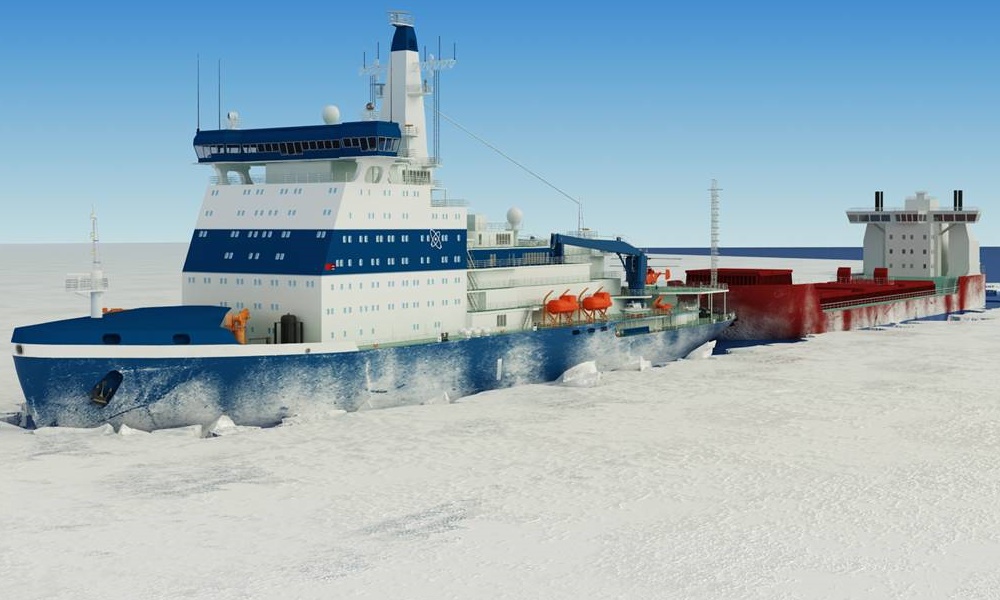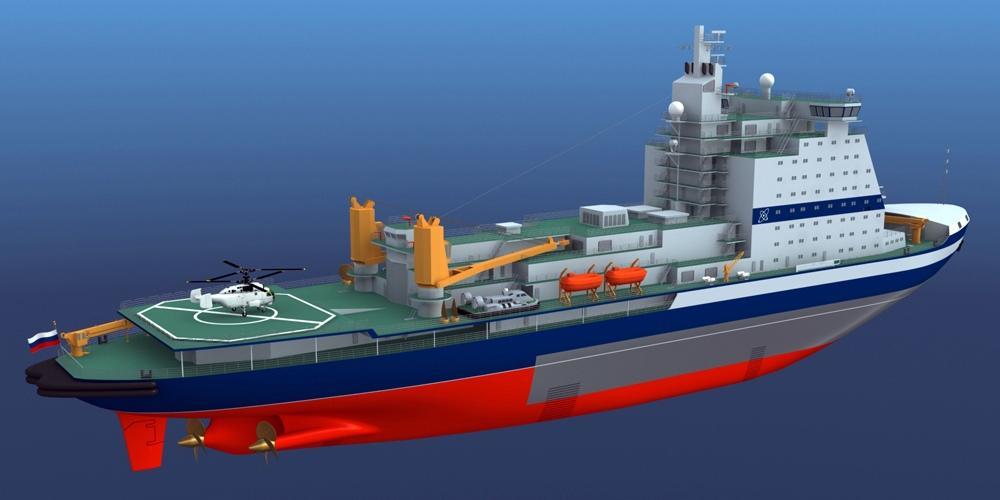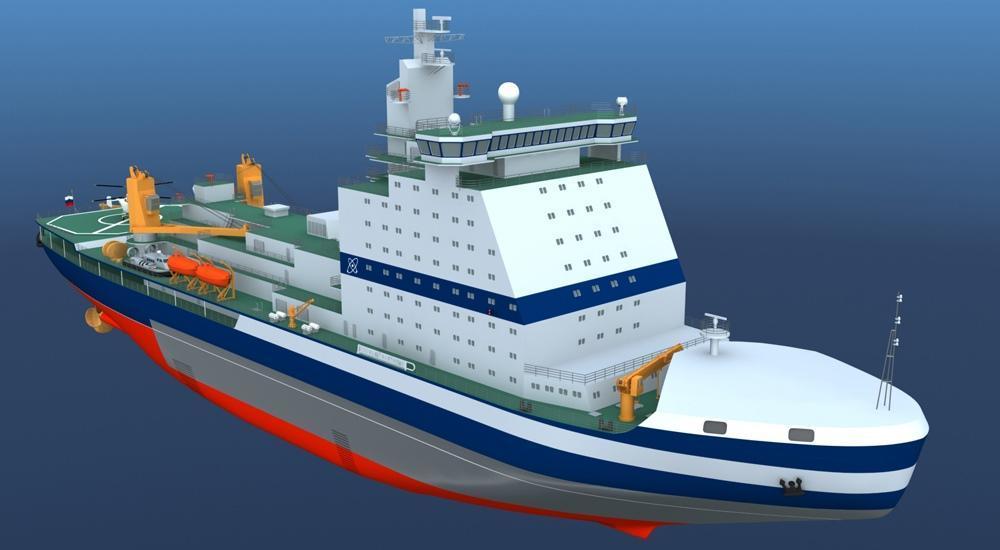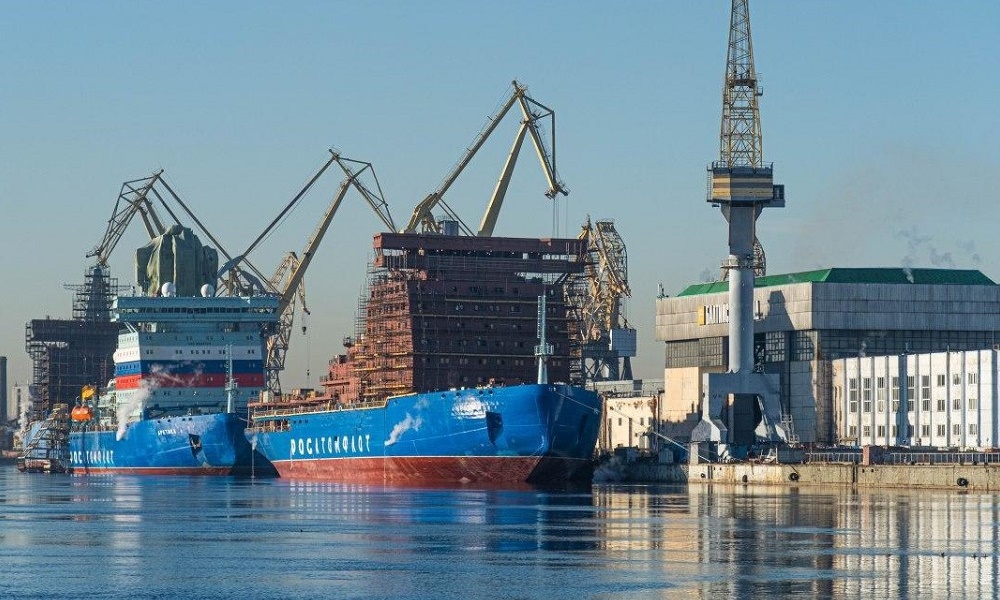NS Stalingrad icebreaker
Former name: NS Kamchatka
Cruise line
Icebreakers
Specifications of NS Stalingrad icebreaker
| Year of build | 2030 new ship |
| Builder | Baltiysky Zavod/Baltic Shipyard (St Petersburg, Russia) |
| Class | Russian nuclear icebreaker (LC-60YA-class, Project 22220) |
| Building cost | RUB 59 billion (USD 851M / EUR 807M) |
| Engines (power) | RITM-200 nuclear reactors (350 MW / 469358 hp) |
| Propulsion power | 110 MW / 147512 hp |
| Speed | 22 kn / 41 km/h / 25 mph |
| Length (LOA) | 173 m / 568 ft |
| Beam (width) | 34 m / 112 ft |
| Gross Tonnage | 33540 gt |
| Passengers | 64 - 128 |
| Crew | 75 |
| Decks | 8 |
| Cabins | 64 |
| Decks with cabins | 5 |
| Sister-ships | NS Arktika (2020), NS Sibir (2021), NS Ural (2022), NS Chukotka (2026), NS Yakutia (2024), NS Leningrad (2030) |
| Former names | NS Kamchatka |
| Christened by | tba |
| Owner | Russian Federation (via FSUE Atomflot) |
| Operator | Rosatom (Rosmorport) |
NS Stalingrad icebreaker Review
Review of NS Stalingrad icebreaker
NS Stalingrad/fka NS Kamchatka ("атомный ледокол Сталинград"/Камчатка) is a new design (world's largest) Russian nuclear icebreaker. "NS" stands for "nuclear ship". The vessel is state-owned (by the Russian Federation via FSUE Atomflot) and operated by Rosatom. Atomflot provides all Russian nuclear icebreakers with maintenance and technological services. The company also serves the country's special vessel fleet.
On November 27, 2023, Andrei Bocharov (Volgograd Region's Governor) announced that Vladimir Putin (Russian Federation's President) has supported the proposal to change the icebreaker's name from Kamchatka to Stalingrad, to honor the memory of the feat of the defenders of the city of Stalingrad during the Great Patriotic War/WW2 (1939-45).
NS Stalingrad is currently scheduled for delivery to FSUE Atomflot and commissioning in December 2030.
The vessel (IMO number 1022964) will be Russia-flagged (MMSI tba) and registered in Murmansk.
Besides NS Stalingrad, the list of other active Russian nuclear icebreakers includes Rossiya (2027/Project Leader), Sibir (2021/sistership), Ural (2022/sistership), Arktika (2020/sistership), Chukotka (2026/sistership), Yakutia (2024/sistership), Sakhalin/Leningrad (2028/sistership), Taymyr (1989), Vaygach (1990), Yamal (1992), 50 Let Pobedy (2007).
Among the newest and largest Russian icebreakers, Stalingrad is the 7th/last of the "Project 22220" ships (aka LK-60Ya). This is a special class of 7x nuclear-powered icebreakers designed and constructed in Russia.
Being the last in the series, NS Stalingrad's/Kamchatka's physical construction/assembly is planned to start in October 2025. The vessel (hull/yard number 05711) will be launched/floated out from drydock in 2028 and is currently planned for delivery/commissioning in December 2028.
The vessel (hull/yard number 05711) will be launched/floated out from drydock in 2026 and is currently planned for delivery/commissioning in December 2030.
These sisterships are currently the world's ever-biggest and most powerful icebreakers, surpassing the "nuclear cruise ship" 50 Let Pobedy (50 Years of Victory) by length (14 m longer) and width (4 m wider).

Negotiations between the Russian companies Atomflot and USC (United Shipbuilding Corporation) have been lengthy. In early 2013, the federal government allocated RUB (rubles) 86,1 billion (or ~USD 1,3 billion) for the project. Rosatom (also state-owned corporation) insisted that the two ice-breaking ships should have a total building cost of RUB 77,5 billion (~USD 1,2 billion). However, the offer was declined by the shipbuilder Baltic Shipyard (aka Baltiisky Yard). A second tender with the adjusted shipbuilding price of RUB 84,4 billion was announced in Dec 2013.
Due to the vessel's dual-draft (8,7 m / 10,5 m), Stalingrad icebreaker's itinerary program is based on Northern Sea Route shipping assistance and includes Arctic Russia sea navigation as well as polar river services. The ship's operational regions in the Arctic Ocean includes Barents Sea, Kara Seas, Pechora River, Yenisei River estuary, Ob River (Gulf of Ob).
Russia's nuclear fleet of ice-breaking vessels is used exclusively in the Arctic Ocean for escorting merchant ships and assisting research stations floating in the ice-covered waters north of Siberia. These ships are also used for scientific and Arctic cruise expeditions. The Russian nuclear ice-breakers must sail in ice-cold waters to effectively cool their reactors.
NS Stalingrad vessel details
Project 22220 class Russian nuclear ships have minimal draught 8,6 m (28 ft) and max draught 10,5 m (34 ft). The dual-draft design makes these vessels capable of operating in both the Arctic Ocean and in ice-covered rivers.

Project 22220 icebreakers are equipped with two RITM-200 nuclear reactors with a total of 350 MW thermal capacity. The propulsion power output is 1100 MW. The previous design was for 60 MW output (the reason why this class is alternatively known as "LK-60"). RITM-200 model is a pressurized water reactor developed by OKBM Afrikantov (Russian mechanical engineering company) and designed to produce power output 55 MWe (megawatt electrical). RITM-200 uses up to 20% enriched uranium-235. The reactor is refueled every 7 years and has planned lifespan 40 years. RITM-200 is also used to power Russia's newest and most powerful aircraft carriers (Project 23000E).
Stalingrad ship's maximum ice-breaking capability is 2,8 m (9 ft) at cruising speed between 1,5-2 knots (2,8 kph / 1,7 mph).
In May 2015 was reported that Russia made a decision on the development of the design for its newest nuclear-powered icebreakers to be able to move across Arctic ice of thickness up to 4.5 m / 15 ft. The icebreaker features propulsion power of 110 MW. Russia's new icebreakers are nearly twice as powerful as Project 22220 nuclear ships.

The steel for the Kamchatka/Stalingrad ship (thick plate "Mill 5000") was supplied by the MMK company (Magnitogorsk Iron and Steel Works). The company is one of the world's largest producers and supplies with steel over 50% of Russia's shipbuilding. Steel plate "Mill 5000" is used for manufacturing Russia's naval fleet, as well as for building tankers and ice-class vessels. The steel is certified internationally, including by Lloyd's Register and Bureau Veritas.
NS Stalingrad vessel has 1 dining room, Sauna, Library, Auditorium, Passenger Lounge, Volleyball Court, Gymnasium, 1 swimming pool (indoor, heated), Infirmary, 1 elevator, 1 helipad (helicopter deck) with a Mi-2 transport helicopter.
- DWT Deadweight tonnage: 9000 tons
- Displacement tonnage: 33540 tons
- Clear path width: 50 m (164 ft)
- Draught: 8,6 m (28 ft min), 10,5 m (35 ft max)
- Height: 52 m (171 ft)
- Icebreaking capacity: 2,8 m (9 ft)
- Ice-class 9 (highest)
- Lifespan: 40 years (designated service life)
- Range: unlimited
- Powerplant: 2x RITM-200 nuclear reactors (175 MW each/total power output 350 MW)
- Propulsion: 3 shafts (combined power output 110 MW)
Russia's Project 22220 ships have an endurance of 6 months (provisions) and 7 years (nuclear reactor fuel).
Note: In the case of poor AIS coverage, tracking the vessel's current location will be impossible.
You can see CruiseMapper's list of all icebreakers and ice-breaking research ships in the "itinerary" section of our Icebreakers hub. All states and their fleets are listed there.
Other Icebreakers cruise ships
NS Stalingrad icebreaker Wiki
One of the world's largest icebreaking vessels, Stalingrad/originally named Kamchatka is scheduled for launch (to be floated out from drydock) in 2026 (November) and is planned for completion and commissioning in 2028 (December).
The vessel's construction/assembly officially started on January 26, 2024, with the keel-laying ceremony held at the Baltic Shipyard in Sankt Petersburg.
The ship has two nuclear reactors (RITM-200 steam generator/power plant), each with thermal capacity 175 MW (350 MV combined power output).
The shipbuilding contract for two more "Project 22220" units (Yakutia and Chukotka/ up to 5x total) was signed in August 2019. Based on the contract, the shipbuilding cost per unit is RUB 50 billion (~USD 720 million / ~EUR 640 million).

The icebreaker was originally named after the Kamchatka Peninsula (part of the Russian Far East territories in the Pacific Ocean/to the west of the Okhotsk Sea). Russian Federation's Kamchatka Krai (administrative region) consists of Commander Islands, Karaginsky Island and the Kamchatka Peninsula. Of the total population (~330,000) most is in Petropavlovsk-Kamchatsky (~180,000) and in Yelizovo (~40,000).
The ship's new name (changed in November 2023) honors the current-day city of Volgograd (established as Tsaritsyn/Царицын) and named Stalingrad in the period 1925-61. The name was specifically chosen to commemorate the Battle of Stalingrad (August 23, 1942, through February 2, 1943) which took the lives of 1,9+ million people.
On September 5, 2021, Rosatom's Deputy Director (Maxim Kulinko) stated that the Northern Sea Route's year-round service requires two additional Project 22220 ships (6th/Kamchatka-Stalingrad, and 7th/Sakhalin-Leningrad). In April 2022 was announced that the Russian Federation plans to allocate from the federal budget RUB 118 billion (~USD 1,7B / EUR 1,6B) for the two additional icebreakers (cost per unit RUB 59B / USD 851M / EUR 807M), with scheduled deliveries in 2028 (December) and 2030 (December).
On February 2, 2023, FSUE Atomflot (shipowner) and JSC Baltiyskiy Zavod (shipbuilder) signed the contracts for the 6th and 7th units (Kamchatka/Stalingrad and Sakhalin/Leningrad) from the Project 22220 series. The order was signed by the General Directors/CEOs of Atomflot (Leonid Irlitsa/Леонид Ирлица) and Baltiysky Zavod (Yury Stepanovic Gordienkov/Юрий Степанович Гордиенков).
FSUE Atomflot officially announced the names of the 6th and 7th ships from the LC-60YA class on March 30, 2023, with their launches scheduled for May 2024 (Kamchatka/Stalingrad) and November 2025 (Sakhalin/Leningrad). As all of the Project 22220 ships, the names honor Russian Arctic territories along the Northern Sea Route (северный морской путь). This shipping route has length ~5600 km / 3500 mi and runs above Siberia (west to east) from Novaya Zemlya to Bering Strait (Cape Zhelaniya).
NS Kamchatka's/Stalingrad's construction officially started with the steel-cutting ceremony on August 14, 2023.
JSC Baltiyskiy Zavod ((1856-established) is a fully owned subsidiary of the state-owned USC/United Shipbuilding Corporation (Russia's largest shipbuilding company). The shipyard specializes in repairs and construction of mainly ice-class vessels (both nuclear- and diesel-powered), as well as floating units (nuclear power plants and distilling plants).
On May 25, 2023, FSUE Atomflot and JSC Baltiyskiy Zavod signed a contract for the construction of a specialized/multifunctional nuclear-technical support vessel (Project 22770 icebreaker) designed to perform a full range of work on refueling (recharging the nuclear power plants) of all nuclear icebreakers, as well as the floating nuclear power plant Akademik Lomonosov (identification MMSI 273381660; 2019-commissioned UNSP barge/unmanned non-self-propelled vessel, in service since May 2020). The shipbuilding contract was signed by Leonid Irlitsa and Yury Gordienkov. The financing was provided 50/50 from the Russian Federation and Rosatom Corporation. The ship (scheduled for completion/commissioning in 2029) has DWT/displacement 22600 tons, hull length 159 m, hull width 26 m, max draft 7,5 m, max speed 12 knots (22 kph/14 mph).
As Project 22220 vessels can navigate both deep (sea) and shallow waters (river estuaries), ROSATOM received two types of ice-breaking ships for the price of one, which means saving hundreds of millions of USD.
NS Kamchatka/Stalingrad and its sisterships are of utmost importance for Russia's strategy to open the Northern Sea Route (NSR) for commercial and military operations the whole year round. By 2030, the NSR will serve vessels carrying 150+ million tonnes of shipments. The Russian Government gave ROSATOM the lead in the route's 6-year infrastructure development project, the total funding for which was RUB 734,9 billion (USD 11,37 billion / EUR 10,17). Of those, RUB 274 billion were provided by the Government, while the remaining RUB 460+ billion were provided by investors, the largest among which are ROSATOM, ROSNEFT and NOVATEK.
ROSATOM (2007-founded) is a state-owned nuclear energy corporation headquartered in Moscow. It comprises over 360 companies and organizations, specializing in scientific research and nuclear weapons, as well as the world's only fleet of nuclear icebreakers. In 2017, ROSATOM produced 202,868 billion kWh of electricity annually or 18,9% of Russia's total electricity. Corporation's construction projects include 33 nuclear powerplant units installed and maintained in 12 countries. It also manufactures related equipment, produces isotopes for nuclear medicine, conducts research and studies, produces supercomputers and software, develops renewable energy technologies (including wind turbines). ROSATOM covers 17,7% of the world's nuclear fuel market and ~35% market share of the global Uranium enrichment services.
ROSNEFT (1993-founded) is a state-controlled gas and oil corporation headquartered in Moscow. The company specializes in research, extraction, production, refinement and transportation of natural gas and petroleum. ROSNEFT is ranked Russia's 3rd largest company and the country's 2nd-largest state-controlled (after Gazprom) and the world's 24th largest oil company in terms of revenue (FY2017 - USD 103 billion / EUR 92,09 billion).
NOVATEK (1994-founded) is Russia's 2nd-largest natural gas producer and the world's 7th-largest stock-listed company by annual natural gas production volume. The company is listed and traded on London (LSE) and Moscow (MCX) stock exchanges. Major shareholders are Leonid Michelson (CEO, ~28%), Volga Group (23%), Total SA (French multinational, ~16%) and Gazprom (9,4%).

